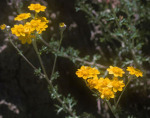
Educational Background
A.B. University California, Santa Barbara
Ph.D. University of California, Los Angeles
Assistant Professor of Biology, Santa Clara University, 1963-1964; Associate Professor, 1964-1969; Professor, 1969-present. General Biology, General Botany, Field Botany, An Introduction to Evolution, Evolution, Biology of Cells, Organisms, Populations, II and III (team-taught), Biology of Populations, Human Ecology, Ecology of California Plant Communities.
Visiting Assistant Professor of Botany, University of California, Riverside, 1961-1963. General Botany, Field Botany, Plant Morphology.
Instructor and Assistant Professor of Botany, Washington State University, 1955-1961. General Biology, General Botany, Introductory Systematics. Instructor in Botany, University of California, Los Angeles, Summers, 1955, 1956, 1957. General Botany. Instructor in Biology, Occidental College, Spring, 1955. Spring Flora.
Research Interests
I am a reader, traveler, and hiker fascinated by the natural history of western North America. I chose research opportunities that most interested me and would contribute substantially to teaching. I study the distribution of western North American plant species and plant communities. Within that, I focus on the comparative study of populations of widely distributed species complexes. (Species complexes are groups of populations where it is difficult to decide whether they comprise one species or several.) Deciphering these relationships entails field work, growing representative populations in a garden or greenhouse, experimental hybridizations among selected populations, and the study of chromosomes in the parental plants and in the artificial hybrids. Much of what I have been able to do stems from early support by National Science Foundation research grants. My current interest is a small annual sunflower, Pseudobahia heermannii, "Foothill Sunburst" or "Brittlestem." Unlike most other species, some plants have six chromosomes, others eight, and a few, ten.
Publications
Book
1958. Laboratory Manual for Introductory Botany, Course 101. (With Adolph Hecht) Washington State University, Student Bookstore
Research Papers
 |
Mooring, J and D. Johnson, Eriophyllum. In Baldwin, B. G., D. H. Goldman, D. J. Keil, R. Patterson, T. J. Rosatti, and D. H. Wilken, editors. 2012. The Jepson Manual: vascular plants of California, second edition. University of California Press, Berkeley.
Mooring, J. 2008. An Eriophyllum Lanatum (Asteraceae) Hybrid Zone in Oregon, Madrono., Vol 55, No. 4, pp. 269-279.
J.S. Mooring. 2007. Supernumerary Chromosomes in Eriophyllum Lanatum and E. Confertiflorum var. Confertiflorum (Asteraceae) Madrono., Vol. 54. No. 1, pp. 30-41.
Johnson, D., and J. S. Mooring. 2006. Eriophyllum, pp. 353-362. In Flora of North America Editoral Committee, Flora of North America North of Mexico, Volume 21, Magnoliophyta: Asteridae, part 8: Asteraceae, part 3. Oxford University Press, New York and Oxford.
Mooring, J. 2002. Experimental hybridizations of Eriophyllum annuals (Asteraceae, Helenieae). American Journal of Botany 89:1973-1983
JOHNSON, D., AND J. Mooring. 2002. Eriophyllum. In J. Hickman, ed., The Jepson Desert Manual, Vascular Plants of Southeastern California. University of California Press, Berkeley, California, USA.
Mooring, J. 2001. Barriers to interbreeding in the Eriophyllum lanatum (Asteraceae, Helenieae) species complex. American Journal of Botany 88:285-312.
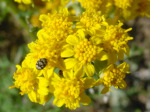 |
Mooring, J. 1997. A new base chromosome number and phylogeny for Eriophyllum (Asteraceae, Helenieae). Madroño 44: 364-373.
Mooring, J. 1994. Spontaneous origin of monosomics and nullisomics in Clarkia unguiculata (Onagraceae) hybrids. International Journal of Plant Sciences 155:471-474.
Mooring, J. 1994. A cytogenetic study of Eriophyllum confertiflorum (Compositae, Helenieae). American Journal of Botany 81:919-926.
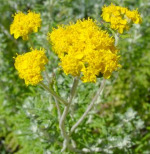 |
Mooring, J. AND D. JOHNSON. 1993. Eriophyllum. In J. Hickman, ed., The Jepson Manual: Higher Plants of California. University of California Press, Berkeley, California, USA.
Mooring, J. 1992. Chromosome numbers and geographic distribution in Chaenactis douglasii (Compositae, Helenieae). Madroño 39:263-270.
Mooring, J. 1991. A biosystematic study of Eriophyllum congdonii and E. nubigenum (Compositae, Helenieae). Madroño 38:213-226.
Mooring, J. 1987 Range extension, chromosome count, and mephitism in Lessingia tenuis (Compositae). Madroño 34:168-169.
Mooring, J. 1986. Chromosome counts in Eriophyllum. (Compositae, Helenieae). Madroño 33:186-188.
Mooring, J. 1983. Cnemidophorus tigris (Western Whiptail). Herpetological Review 14(4):123.
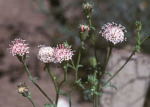
Mooring, J. 1980. A cytogeographic study of Chaenactis douglasii (Compositae, Helenieae). American Journal of Botany 67:1304-1319.
Mooring, J. 1975. A cytogeographic study of Eriophyllum lanatum (Compositae, Helenieae). American Journal of Botany 62:1027-1037.
Mooring, J. 1973. Chromosome counts in Eriophyllum and other Helenieae (Compositae). Madroño 22:95-97.
Mooring, J. 1966. Chromosome numbers in the Eriophyllum lanatum (Compositae, Helenieae) complex. Madroño 18:236-239.
Mooring, J. 1965. Chromosome studies in Chaenactis and Chamaechaenactis (Compositae, Helenieae). Brittonia 17:17-25.
Mooring, J. 1961. The evolutionary role of translocations in Clarkia unguiculata (Onagraceae). Recent advances in botany, pp. 853-858. Univ. Toronto Press, Canada.
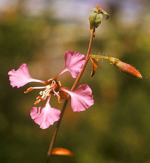
Mooring, J. 1960. A cytogenetic study of Clarkia unguiculata. II. Supernumerary chromosomes. American Journal of Botany 47:847-854.
Mooring, J. 1958. A cytogenetic study of Clarkia unguiculata. I. Translocations. American Journal of Botany 45:233-242.
